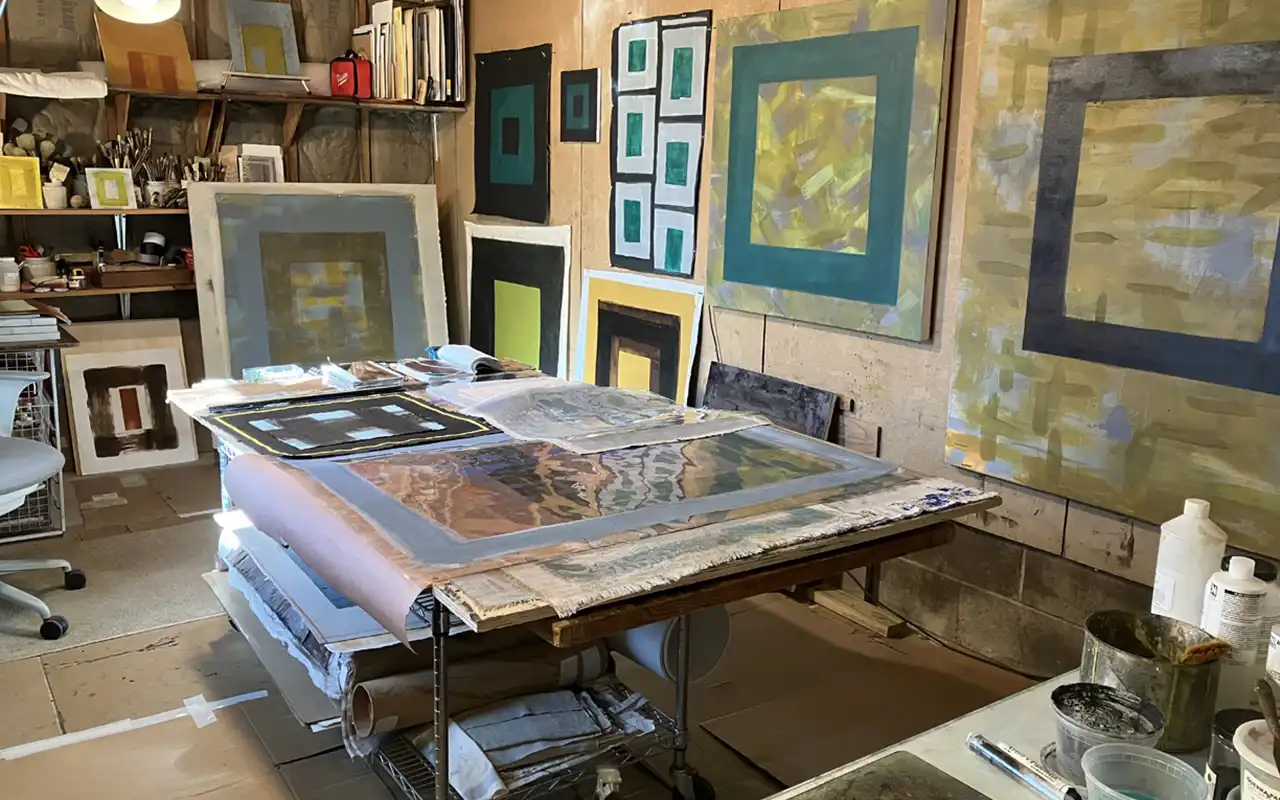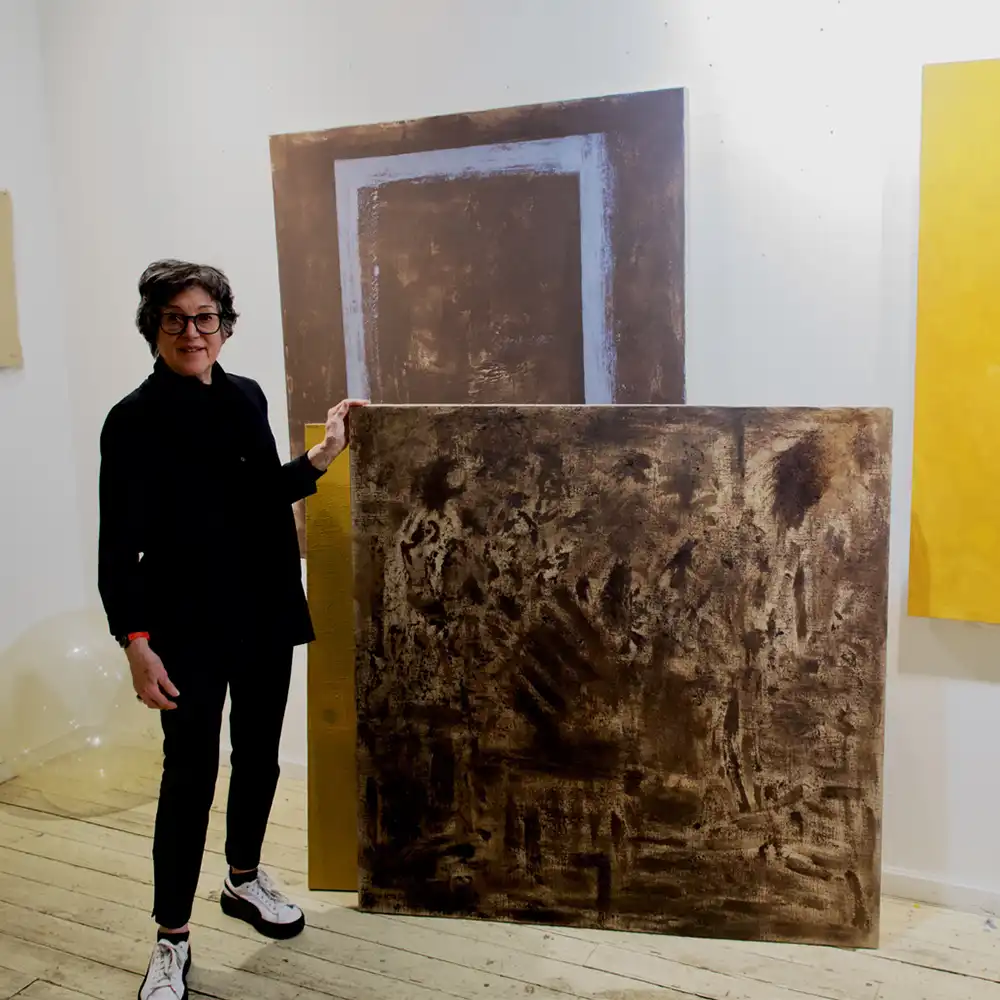Featured Artist

An Encounter with Chance
Marthe Keller and I had lengthy conversations in both her studios, firstly in her downtown artist loft in New York City and secondly in Falls Village, CT. Her studio loft building originally manufactured sail canvas for shipping; huge bolts ran the depth of the building. Later it provided a space for artists to purchase their canvas. Marthe moved into this unique artist loft in the 1970s. Tall cast iron columns hold up the tin ceiling while old pulleys and tackle remain on the walls, leaving clues to the bones of the place. The energy of creative spirit is embedded in the walls, hand in hand with Marthe’s enthusiastic dialogue about an artist’s life.
 Early days of art
Early days of art
“I am a New Yorker; I was born and lived on Bethune Street, in Greenwich Village until our family moved north, first to Croton-on-Hudson, then onto a communal farm in a hamlet called Roseton. My father, an artist, built his new studio, there and I grew up surrounded by art and artists. My early learning was in a small four-room schoolhouse with the local children of brickyard and farm workers, a simple world where we swam in a clay pond and enjoyed hootenannies with Pete Seeger.” Keller continued, “Roseton sadly no longer exists; the central Hudson steam station swallowed it up, and it was relegated to a ghost town. In 1961, we all departed for Rome, Italy, where I was immersed in Europe’s art with my parents as guides. I lived in Rome through high school and revisit annually.”
Keller said, “My art career began at Boston University, which was so conservative that we were not allowed to paint an abstract painting. Deeply frustrated, I transferred to the Maryland Art Institute, where we were reminded, ‘Women can’t be artists; there is no room for you in the art world. Just forget about it. You’ll have babies; leave artmaking for the men.’ It was so provoking that I sought out an art therapy degree.”
“However, still craving my crayons, and acknowledging that creating art was my passion, I escaped. I jumped into my tiny car and headed west to New Mexico to explore America. This vast red landscape, where colored shapes erupted from the earth, felt like a wild abstraction. It was mind-blowing to be in such an expansive space after Italy. I received a grant for costume design at a dance company in Albuquerque, with New York dancers influenced by John Cage and Merce Cunningham. Here, I felt the inspiration of Cage’s method of chance, inventing my concepts to allow chance to be part of my practice,” Keller shared.
Marthe Keller in her Italian cow barn studio
Returning to Italy, Keller was offered a studio in an artist’s old cow barn. This barn’s curved door created an arc shape, initiating a series of early works. Blind Dream IV, 1987 from this series hangs in Keller’s loft; the light plays on the graphite surface of an arced shape within a square. Baseball fields also became her muse; they also describe a curved shape within a square. Brad, her husband, gave her an actual home plate as a gift.
Another painting hanging in the loft, Summer Dispersion, is evidence of Keller’s constantly exploring processes with varied materiality. Her abstract practice investigates surfaces, plays with transparency and opacity, and works with horizontal and vertical bands.
A larger version of this painting hung in the Metropolitan Museum for many years.
Who were your key influencers?
“When we lived in Italy, my parents wanted to see everything, I inhaled art: ancient Roman walls, Baroque architecture, Giotto, Piero, the Arte Povera movement, Alberto Burri, and Lucio Fontana. In the 1980s, I met Sol LeWitt, and his concepts freed me. I happily became one of his draftspeople; we had fun making wall drawings in private collections, galleries, and museums. Working on such a scale was liberating. His concept was that an idea described in words is the artwork. A collector purchases a numbered certificate describing the artwork. The instructions in the certificate can be followed to create the artwork on a wall, but the concept exists as an artwork even if the drawing is never made. The value is the concept described by LeWitt. Each rendition differs depending on the site, but the artist’s hand follows the directions and should always try to remain the same. In public, these wall drawings stay up for the length of a show, or they may be permanent. Occasionally, I am still asked to make a wall drawing. MASS MoCA has installed 100 Sol LeWitt Wall Drawings for 25 years, which is worth a visit,” Keller shared.
She continued, “John Cage’s method of chance has remained throughout my practice. Rothko, Burri, and Newman also played roles in my work. More than the dead men, though, many artist friends have been influences, such as Carmengloria Morales, one of the few women of stature given equality to men working in Italy now. I believe the universe will bring what is needed when I need it. After years of painting, I feel free to allow the materials and colors to create the work.”
Do you have a routine that is part of your making?
“Tai chi and tidying are part of my daily practice. In the morning, I tend to focus on business. Later, I’ll have a cup of tea, get into the zone, work until late, and mess it all up again. I’m also rather stingy and dislike throwing paint away; there are always half a dozen pieces of paper next to me to make smaller versions. I also enjoy making a game of using Finnegan’s Wake by James Joyce, as many other artists have done, to randomly choose titles for the last 30 years. Joyce’s voice offers a hilarious, absurd, and essential trove of added meaning to the work,” Keller said. A well-thumbed edition sits on her art table.
Keller sometimes works directly on the wall, on unstretched fabrics, with wood, or by utilizing found objects. Surface is a critical essence of Keller’s work. She has pushed boundaries using found earth, pigments, graphite, ink from black walnuts, and mark-making from places, continually challenging the surface, the line, and the texture. Incorporating tiny glass beads into the pigments, akin to those for traffic signage, allows light reflection against matte paint.
Her surface qualities embody wax encaustic, matte, shimmer, rough, or smooth. These are often created with a single gesture drawn using her own multiple brushes bound to one handle. A musical staff for chalk can hold two or five brushes; in varied dimensions. The brush holder keeps the spaces between strokes equal and allows a significant gesture to be made with multiple brushes but without the bravado of expressionism. “Repetition comes from my single painting gesture, which takes the ego out of the work.”
A similar distancing mechanism employs printing methods using transparent vinyl to transfer shapes onto the painting surfaces. Sometimes, the vinyl image hangs away from the surface to invite ‘chance,’ incorporating the angle of light to move a shadow drawing throughout the day.
“I inherited my father’s Italian collection of cosmetic-grade pigments used in Fresco painting. They remained untouched for years as I found the colors too dull. I wanted a more electric tone in my earlier work. Recently, it was a joy to rediscover these earth pigments in the studio. Once, I found a nitrogen fertilizer, Blood Meal, in my brother-in-law’s garage and used it to make paint. It is also an ancient pigment,” she shared.
Keller is undaunted by size, creating extensive installations, from 30-foot wall drawings to intimate pieces that float off the wall on unstretched linen at eye level. Her fearless practice and belief in her work resonates strongly. She holds true to the Italian term for leftovers, avanzi, meaning to take it forward.
Can you discuss how an artist navigates different studio spaces to work?
“I have an unplanned five-year cycle to change environments and studios; this New York space is my ground zero. Once, I worked for five years in Red Hook, Brooklyn, on the Buttermilk Channel, watching the ships go by. However, when I felt my work shifting towards sunsets – and I’m not a landscape painter despite earth pigments embedded in the work – I returned to the city, where the work transferred to the vertical. I relish new spaces to see what materials they gather. In truth, I am inspired by what’s in the moment, and light is probably one of my biggest inspirations, so I am also drawn to working in Italy and upstate, away from the city. In Falls Village, I work in this funky garage that needs renovation, but I love it. I hope to enlarge it with McVoy and O’Neill, excellent architects willing to trade art to work on it! Transitioning between these opposing spaces allows a pause in the work and a fresh eye,” Keller explained.
Can you discuss the Bau residency program you set up?
“Inspired by a life-changing residency at McDowell, I advocated for artist residencies. My architect friend, Paola Iacucci, and her painter husband, with a group of Milanese abstractionists, annually headed to Otranto in Puglia, Italy. Later, Professor Iacucci set up an architecture program for students from Columbia, Cooper Union, and other schools. Derived from the concepts of building, arts, and urbanism, the name BAU was given. The town allowed Paola’s group to use the ruined castle of Otranto as an incredible studio within the ancient castle walls.” She continued, “In 2004, I collaborated with Paola to transition BAU Institute into an arts and culture residency for creative professionals. Over 300 artists, writers, dancers, and others have enjoyed BAU. When the town became a world heritage site and was funded by the EU, converting our castle into a museum, we retired from BAU Institute in 2015. The Italian residency ceased, however, we navigated BAU Institute to The Camargo Foundation in Cassis, France, where it still offers a BAU summer residency for artists.”
What advice do you have for younger artists today?
“I’ve taught painting and drawing at all levels at many universities. Currently, I’m teaching a foundation class at Hunter College. Teaching the beginning stuff is rewarding as you see the light bulbs go on. My advice is not to be an artist if you are ambivalent. If creating art is all you can visualize, if it is what you really desire – go for it, but if you can do anything else, don’t become an artist. I always stress that artists rarely support themselves with their work.”
She continued, “The joy of being an artist is being in the moment, holding onto what you find, and embracing the uncertainty, an essential aspect of painting. Painting teeters between two identities: being a thing itself and being an image of a thing. Ultimately, the meaning depends on the artist’s intent. I am so lucky that I can keep making work forever.”
While we talk, her cat bounces delicately across the studio shelves, mindful of paint and pigment and possibly in search of some fun.
Keller has shown work in the USA, Italy, and Germany. She is a member of the historic American Abstract Artists group. Her work is represented in the Whitney, the Met, and MoMA, and she has received grants from NYFA, NEA, and MacDowell. •
To learn more about Marthe Keller you can visit marthekeller.com or email her at marthe@keller-email.com. Also learn more at americanabstractartists.org.
